Mark Sisson's Blog, page 85
January 2, 2020
When Does Fasting Cross the Line?
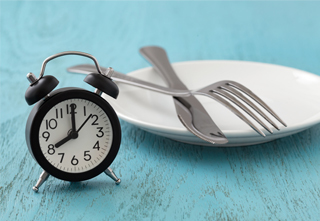 A little while back, Mark posted an article about 14 scenarios in which intermittent fasting (IF) might be just the ticket. We got some requests for a follow-up about times when IF might not be advised.
A little while back, Mark posted an article about 14 scenarios in which intermittent fasting (IF) might be just the ticket. We got some requests for a follow-up about times when IF might not be advised.
Mark has already written about cautions for women and athletes specifically. I’ll link those at the bottom. More generally, it’s important that anyone considering IF make sure that they are in a good place physically and mentally to handle the additional stress of IF.
As Mark said:
If you haven’t satisfied the usual IF “pre-reqs,” like being fat-adapted, getting good and sufficient sleep, minimizing or mitigating stress, and exercising well (not too much and not too little), you should not fast. These pre-reqs are absolutely crucial and non-negotiable, in my opinion—especially the fat-adaptation. In fact, I suspect that if an IF study was performed on sugar-burning women versus fat-adapted women, you’d see that the fat-burning beasts would perform better and suffer fewer (if any) maladaptations.
Fasting is generally healthy when done properly. The same goes for exercise and carb restriction. These behaviors help many people; but they can also be unhealthy for certain people or when used too much or in the wrong circumstances.
Today I’d like to wade into potentially controversial waters and talk about when fasting potentially crosses the line into disordered eating territory.
Before You Get Defensive…
If you find yourself feeling defensive already because you enjoy fasting and think that I’m going to suggest that you have a problem, please hold off commenting until the end.
To be clear: I do not think that fasting is inherently disordered. However, its popularity has skyrocketed so rapidly, and its proponents are so enthusiastic, that the potential downsides have been overshadowed. Actually, that’s not entirely fair. I have seen plenty of people in mental health and disordered eating circles voice concerns. The ancestral community tends to be very rah-rah about fasting.
The goal for today is to shine a light on this issue so that we don’t go into fasting with a blind spot.
Eating Disorders vs. Disordered Eating
The prevalence of full-blown eating disorders (ED) is fairly low according to NEDA, the National Eating Disorders Association. Experts believe biological and/or psychological predispositions make certain individuals vulnerable. These predispositions probably interact with environmental factors to trigger ED.
That said, many more people engage in disordered eating behaviors. The behaviors and their effects are not problematic enough to qualify for diagnosis with ED, but they still negatively affect physical and/or mental health and quality of life. Depending on their severity, they might be considered suboptimal to truly unhealthy.
Before going any further, let me be clear: I’m not in any way trying to diagnose readers with ED or disordered eating. That is way beyond my pay grade. Nor should you self-diagnose. If you want to learn more or get help, the best place to start is with NEDA’s Help & Support center. They have an online screening tool and a helpline there.
As I said, I don’t think fasting is inherently bad. However, NEDA lists fasting among the behaviors that can be indicative of ED. Of course, professionals in the ED and mental health worlds are looking at fasting through the lens of restricting and exercising tight control over food intake. We in the ancestral health space tend to look at it through the lens of optimizing health.
Neither perspective is more correct. It’s all about context:
why you’re fasting,
how fasting makes you feel physically and mentally,
whether it takes over your life,
if you are using it in a way that is actually undermining your health,
whether you are taking it “too far” (admittedly a nebulous metric)
As with so many things, deciding if you’ve crossed the line is highly personal. This applies to much more than food. When does worry become anxiety? When does fear become a phobia?
One criteria might be whether fasting causes you distress. Another is whether it interferes with your quality of life, social relationships, and work. This is called the criteria of clinical significance in the DSM-V, the diagnostic tool used by mental health professionals.
It’s often apparent, though not always easy to accept, when a behavior is no longer serving us. Unfortunately, though, it’s not always that simple. When it comes to fasting, it can cross over into problematic territory and still feel good.
Wouldn’t I Know If My Fasting Regime Was Too Much?
Maybe, maybe not. Restricting calories and fasting can lead to elevated mood, increased energy and motivation, and even feelings of euphoria. (Fasting that doesn’t result in a caloric deficit might be less prone to this.)
There are physiological reasons why this might be the case. First, scientists hypothesize that this is an adaptive response. If you were truly starving, this increased energy, drive, and focus would help you redouble your efforts to find food.
There is also some evidence that food restriction affects serotonin and dopamine pathways and can, for some individuals, reduce anxiety. Researchers believe that this is one way anorexic behaviors are reinforced in the brain. Again, fasting and anorexia nervosa are NOT the same animal, but they can share common features. The “high” associated with anorexia nervosa sounds not unlike the profound energy and cognitive benefits that some people report with fasting.
All this is to say, food restriction can feel good. For some people—or more accurately, for some brains—the withholding of food becomes inherently rewarding. In that case, you wouldn’t necessarily recognize when enough is enough.
How Do You Know If You’ve Crossed the Line?
I’m not going to be able to provide a definitive answer here. That said, these seem like potential red flags:
Fasting makes you feel euphoric. That doesn’t necessarily mean it’s harmful by any means. Still, take a step back and evaluate whether you are always making healthy choices.
Your fasting regimen causes distress or significantly interferes with your life.
You feel like you have to fast or something bad will happen.
When you eat after a fast, you feel out of control with your food intake or binge.
You’re ignoring symptoms that might be related to too much fasting: adrenal or thyroid issues, fatigue, hair loss, weakness or inability to perform usual workouts, sleep disturbances, too much weight loss, etc.
Again, I am in no way diagnosing anyone here. If you think that perhaps your behavior has crossed into unhealthy territory, you should seek the counsel of someone trained in these issues.
The Bottom Line
Fasting, though it confers certain health benefits, is not good for every person. Experts recommend that individuals at risk for developing ED or with a history of ED refrain from fasting, including intermittent fasting, altogether. Even if you don’t think you’re at risk, it still might not be in your best interest.
Because fasting is so popular right now, some people think they have to fast for optimal health. They worry that they are missing out on tremendous health benefits if they can’t or don’t want to fast. The main reasons people fast are autophagy, glycemic control, and fat loss. You can achieve all of those goals through means other than fasting.
Remember, too, that you need not rigidly adhere to the same eating window every single day. It is fine to fast stochastically, to borrow from Paleo OG Art De Vany. You might also consider doing one longer fast a few times per year instead of daily intermittent fasting.
In any case, if fasting is wrong for you, it’s wrong for you, period. It doesn’t really matter if your neighbor loves it or the lady in the next cubicle lost 60 pounds with IF. If it negatively impacts your physical and/or mental well-being, it’s not worth it.
And in case this isn’t perfectly clear: Enjoying fasting DOES NOT MEAN that you are doing anything wrong. On the contrary, I hope you are enjoying fasting if it’s a tool you’re using regularly. Feeling great is the goal. If it’s not negatively affecting your physical health, psychological well-being, or social relationships, it’s not problematic. Likewise, if you are consuming enough calories when you do eat, and you’re able to be flexible with your fasting schedule when the situation calls for it, you likely don’t have to worry.
This issue can be hard to talk about because so many people feel passionately about defending their way of eating. Those who question whether fasting is always healthy, or who point out that a desire to eat healthfully can sometimes slip into orthorexia, are accused of “fit shaming.”
However, not talking about it isn’t the answer. Our goal should be to bring these issues into the light and try to better understand them. Then we can make informed decisions about which behaviors best serve us now and in the future.
Related Posts from MDA
Intermittent Fasting for Women: What We Know Now
Dear Mark: More on Women and Fasting
Intermittent Fasting For Athletes: Benefits and Concerns
12 Intermittent Fasting Tips for Athletes
Fasting versus Carb Restriction: Which Works Better for What Scenarios
References
Kaye, WH, Fudge, JL, Paulus, M. New insights into symptoms and neurocircuit function of anorexia nervosa. Nat Rev Neurosci. 2009;10: 573–584.
Kaye WH, Wierenga CE, Bailer UF, Simmons AN, Bischoff-Grethe A. Nothing tastes as good as skinny feels: the neurobiology of anorexia nervosa. Trends Neurosci. 2013 Feb;36(2):110-20.
The post When Does Fasting Cross the Line? appeared first on Mark's Daily Apple.



January 1, 2020
Common New Year’s Resolutions (and How I’d Rewrite Them)
 A big problem with New Year’s resolutions is not something intrinsic to the practice of resolving to make positive changes in the coming year—these can be beneficial forces in a person’s life—but with the way we word our resolutions. Word choice determines everything. Words mean things. The words we use determine everything that follows. With just slight modifications to the wording and by being more specific, these resolutions can become more powerful, more effective, and more true to our nature and our actual desires.
A big problem with New Year’s resolutions is not something intrinsic to the practice of resolving to make positive changes in the coming year—these can be beneficial forces in a person’s life—but with the way we word our resolutions. Word choice determines everything. Words mean things. The words we use determine everything that follows. With just slight modifications to the wording and by being more specific, these resolutions can become more powerful, more effective, and more true to our nature and our actual desires.
How would I rewrite eight common New Year’s resolutions?
“I’m going to lose 50 pounds.”
This might be the most common goal. The world has a growing obesity problem, and the vast majority of people implicitly understand that this is indeed a problem to be solved. But “I’m going to lose 50 pounds” doesn’t give you a roadmap. It doesn’t even give a specific destination. Are you going to lose 20 pounds of fat and 30 pounds of muscle? Are you going to count calories? How many do you plan to burn and consume? What are those calories going to consist of?
This is better: “I’m going to lose body fat and gain or retain lean mass by eating foods that naturally increase satiety and inadvertently cause a reduction in calories.”
“I’m going to focus on my relationships.”
A noble goal, to be sure, but what does it mean? Which relationships? How are you going to “focus” on them? Determine which relationships you’re most concerned with and identify what they lack and require most. Then, resolve to provide what they’re missing.
Better options: “I’m going to find a reliable babysitter and plan a date night every Wednesday with my wife/husband.” Or: “I’m going to read to my kids every night.” Or: “I’m going to get together every Sunday morning with my friends to hike/grab coffee/work out.”
“I’m gonna exercise more.”
This is a popular resolution, and, at least for a couple of weeks, people stick with it. But around mid-January, the gym depopulates. The newcomers all migrate elsewhere. They don’t stick with it, despite quite honestly wanting to work out more often. What goes wrong?
They’re not specific. They don’t make concrete plans or set a schedule. It’s one thing for someone with a lot of gym and training experience to practice “intuitive training,” where they just do what feels right and interesting. That’s pretty much how I train, but I’ve been doing fitness for most of my life. The total beginner will flounder if they try to go to the gym without any experience or any plans.
Better options: “I’m going to lift heavy things twice a week, go for a 30-minute walk every day, and do some intense anaerobic activity like sprints or rowing.”
“I’m going to meditate.”
I see it all the time. Someone listens to a podcast with a business guru who swears meditating got him where he is today, and that it’s the single most important thing anyone can do. They try meditating, and it just doesn’t work. They can’t stick with it. So New Year’s rolls around, and they resolve to finally make it happen.
Maybe meditation will work. Some say that it’s those who have the most trouble meditating who need it the most. Perhaps. But as someone who’s dedicated to improving myself and never has trouble doing hard things like lifting or pursuing business ideas or taking risks, meditating simply didn’t work. What did work?
Going for walks in nature.
Going paddle boarding.
Even guided meditations worked better for me.
In essence, “finding the flow” is what worked. Finding that activity that allowed me to turn off my mind and just be.
Better options: Find the thing that allows you to reach that Primal state of flow. “I’m going to go for a quiet walk without any stimulus in nature every single day.” Or: “I’m going to go surfing/rock climbing/play music.”
“I will live life to the fullest.”
Too often this translates as, “I will stay up late getting black-out drunk as often as possible.” Maybe that’s someone’s “full life,” but I don’t recommend it. That doesn’t take “resolve” to do. That’s the kind of thing that people revert to when their better inhibitions fail. It’s the opposite of what a good resolution looks like.
Better: “I will embrace looking stupid and try new things that I’ve always wanted to do but have felt nervous about being bad at.” Or: “I will pick something new and novel to do at least once a week (with an allowance for repeating if the new activity sticks).”
“I’m going to learn a new skill/language.”
Be more specific. What are you going to learn? What is the thing that keeps surfacing in your mind as you drift to sleep? What do you dream about? What do you keep noticing in your everyday life?
Better: “I’m going to learn how to change my brake pads.” Or: “I’m going to learn German.” Or: “I’m going to take judo classes.”
“I’m going to stop drinking.”
This is a noble resolution, but it may not be effective by itself. When someone’s alcohol intake becomes a problem, it’s usually masking a deeper issue. People don’t drink to excess because they’re celebrating real life too much or living a totally fulfilled life when sober. Drinking becomes a problem because you’re covering something up.
Instead of just “not drinking,” plumb the depths of your soul to determine the true cause of your over-indulgence in alcohol. Figure that out, come to peace with it, and figure out a resolution to address it. In doing so, you will have a better chance at fixing the drinking.
A better option: “I’m going to figure out and overcome the reasons I’m drawn to drink so much alcohol.”
“I’m going to read more.”
I’m a bibliophile. I understand the joy of reading books and the frustration that comes when the end of the year rolls around and I realize I haven’t read as many books as I would have liked. There are so many to read, so little time, and time squandered is reading time you won’t get back.
“Books” is such a general category to be useless. Get more specific about what kind of book you want to read. Read only what you truly enjoy. Don’t feel guilty about stopping a book after 30 pages if it hasn’t grabbed you (it’s just an inanimate object, it won’t feel anything). Go to the library (having a time limit forces your hand; sometimes owning a book means you shelve it and forget it).
Better: “I’m going to read books I enjoy and quit books I don’t without feeling guilty.” Or: “I’m going to get a library card and start checking books out.” Or: “I’m going to read more fiction.” Or: “I’m going to flip through books and read what I want without worrying about reading the whole thing.”
The hardest resolution is the one we can sense but can’t articulate. In my experience, almost everyone in this modern age is missing something, is searching and yearning for something that they can’t quite pin down. If it exists in some immaterial dimension of potentiality outside of language, the resolutions we write down won’t capture it. That, I suspect, is a major reason the resolutions we choose do not complete us.
How do we fix that one? How do we find it? Maybe by moving through the world, by throwing ourself into meaningful pursuits that resonate in the moment, by taking long walks and letting the mind and body wander where they will, by letting go of our need for constant stimulation and embracing boredom.
What are you resolutions this year? If you could rewrite them, what would you say?
Have a great New Year, folks. Take care!

The post Common New Year’s Resolutions (and How I’d Rewrite Them) appeared first on Mark's Daily Apple.



December 31, 2019
Keto Q&A: Diving Into Keto For Life
 We didn’t set out with the intention, but somehow it happened. Keto For Life was assigned a release date of New Year’s Eve—tomorrow, in fact. While there’s never a wrong day to go keto, my writing partner, Brad Kearns, and I felt like the stars aligned. Just when countless people are taking stock at the turn of new decade, wondering what might be possible in their lives, this message would be there. And while a lot of books will be there, too, with promises of weight loss and fitness and wellness, I have to say (biased as I may be) that Keto For Life offers something unique and sustainable among the typical cacophony of health tracts.
We didn’t set out with the intention, but somehow it happened. Keto For Life was assigned a release date of New Year’s Eve—tomorrow, in fact. While there’s never a wrong day to go keto, my writing partner, Brad Kearns, and I felt like the stars aligned. Just when countless people are taking stock at the turn of new decade, wondering what might be possible in their lives, this message would be there. And while a lot of books will be there, too, with promises of weight loss and fitness and wellness, I have to say (biased as I may be) that Keto For Life offers something unique and sustainable among the typical cacophony of health tracts.
While I’ve shared its premise and outline on the blog, today I’m taking up some questions readers have shot my way over the last few weeks. What does it cover that other books haven’t? Does it offer a new take on longevity? How do other principles come into play beyond diet? I’m covering all that and more.
How does Keto For Life differ from The Keto Reset Diet?
Since the start of Mark’s Daily Apple, my core purpose has been to present a counter-argument against flawed and dated conventional wisdom. On the blog here and in my books beginning with The Primal Blueprint in 2009, I’ve focused on presenting the scientific rationale and practical steps for how to escape carbohydrate dependency and become fat- and (more recently) keto-adapted. I’ve made the case for rejecting the “struggle and suffer “ethos of chronic cardio in favor of a Primal approach emphasizing comfortable paced movement and aerobic workouts, lifting heavy things, and sprinting once in a while. And, finally, I’ve emphasized the non-negotiable importance of complementary lifestyle behaviors like getting enough sleep, sun, and play.
All of us in the ancestral health space have been heartened to see how far we’ve come in the past decade. Many ancestral health principles have been widely validated by science and accepted into mainstream culture in a relatively short amount of time. Back in 2009, it was hard to find someone who had any awareness of Primal/paleo/low-carb eating (including major New York publishers—that’s why I had to start Primal Blueprint Publishing!). Today, it’s a different ball game. The movement’s growth over the past decade has allowed discussion to refine and advance. Without the need to push just the basic premise, there’s been more momentum around deeper, more productive levels of personal customization. The keto and carnivore diets are examples of these ancestral offshoots.
The Keto Reset Diet was one of the first comprehensive books published on the subject, but it’s primarily a diet book—how to proceed in a comfortable step-by-step manner to embrace the ketogenic diet without the risk of backslide and burnout that comes with an ill-advised approach. It does cover the complementary exercise, sleep, and stress management practices that support your dietary goals, but the central focus is on introducing the ketogenic diet to the masses.
Keto For Life picks up where The Keto Reset Diet left off by having you leverage the metabolic flexibility you attain from keto efforts and applying it to the ultimate goals of living long and living awesome. In particular, it integrates the critical components of mindfulness, social wellness and emotional well-being for enhancing longevity and enjoying a fulfilling life. It moves beyond the core ancestral health message of “mechanics”—mechanics of eating the right foods, of doing the right workouts, of quantifying everything and checking every box…but with that potential big void of “Are we having fun yet?” Keto For Life leads with life. The focus is squarely on the good, long life we all hope to achieve.
What Does Keto For Life have to say about longevity?
We played around with using the term “longevity” in the title, but who cares about longevity by itself? Today, most people can make it to the average U.S. life expectancy of 79, but too many limp to that finish line, having endured decades of pain, suffering and limitation. The United States ranks 26th out of 35 economically advanced nations in life expectancy, a pathetic showing for the richest and most medically advanced nation in the history of humanity. In Keto For Life, we tackle the goal of healthspan, which conveys both living long and living awesome. Healthspan entails not just checking all the boxes of healthy foods, exercise output and sleep hours; it also means having fun and finding fulfillment along the way. With the Four Pillars of Keto Longevity, we incorporate healthy eating, movement and physical fitness with the concepts of Mental Flexibility and the often-overlooked pillar of Rest and Recovery.
How does compressed morbidity fit in here?
Compressed morbidity describes being healthy, strong and cognitively sharp for as long as possible. Then, by the time the natural inevitabilities of chronological aging come into play, the end is quick and peaceful. Brad’s father Dr. Walter Kearns was a stellar example of this concept. He passed in May of 2019 at the age of 97. Ninety-five of his years were characterized by exceptional mental and physical function. A champion golfer for his entire life, Walter shot below his age over 1,2000 times, including shooting an even par 71 at age 87 and a 76 at the age of 92. Walter was a general surgeon who continued to serve as a physician for decades after closing his private practice. He worked for the Indian Health Service into his late 70s, and volunteered at a weekly diabetes clinic until he was 95. In his final two years, Walter’s cognitive and physical performance started to decline. His golf outings went from 18 holes for money to casual 9-hole outings, and eventually to hitting chip shots in the backyard. He started to take longer naps, eat less food, have longer nights of sleep and shorter walks at the park. Soon, the day came for him to pass peacefully at home, with none of the drama, suffering, or family fatigue of someone paying the price for decades of adverse lifestyle practices with chronic disease patterns.
Going for compressed morbidity is about keeping muscle mass on your body (promoting a concept called organ reserve I’ve discussed at length in The Primal Blueprint and on the blog) as well as your brain! In a pattern that appears often in the book, the Four Pillars are complementary here. Eating an ancestral-style diet in general and making a devoted effort to become keto-adapted (even if you don’t stay in strict keto over the long-term) strongly supports cognitive function. You may have heard the disturbing new nickname for the assorted cognitive decline conditions that are growing at epidemic rates: Type 3 Diabetes. This term was coined by noted researcher Dr. Suzanne de la Monte of Brown University, conveying how cognitive decline is marked by dysfunctional glucose metabolism in the brain. As de la Monte explains, cognitive disease “has molecular and biochemical features that overlap with both type 1 and type 2 diabetes.”
We hear sound bites about doing Sudoku to ward off dementia, but I go far deeper in this book. Extensive research shows us how a vibrant social network, a strong sense of purpose, and a positive self-perception about aging drive healthy cognitive function and extended lifespan. One longitudinal study from Yale tracked a group of 50+ people in Ohio for two decades, revealing an amazing result: Those with a positive self-perception about aging lived 7.5 years longer than those with negative self-perceptions about aging! This tidbit earned distinction as the lowest hanging fruit in the entire book to quickly add years to your life. The longevity champs in Okinawa also get recognition here for their emphasis on yuimaru, a deep sense of social obligation to family, friends, and neighbors. One of the most revealing longevity stats you will ever find is that Okinawan’s who leave the island live 20 years less than those who spend their entire lives on the island.
What’s the #1 quick takeaway from the Mental Flexibility pillar?
“Pivot.” Is that quick enough for you? Thanks for asking. Next question.
Pivot—really?
I can’t think of a more powerful word to convey the secret to experiencing a life filled with happiness, contentment, purpose, and meaning. I credit the ability to pivot as the key to my entrepreneurial success, and also to my ability to sustain a respectable level of work-life balance. As I shared in my introductory post about the book, pivoting describes being able to go with the flow when facing life change. Pivoting is accepting failure and setbacks with grace and resilience instead of allowing bad stuff to bury you. Pivoting is also knowing when to hold ‘em and when to fold ‘em. It’s impossible to be perfect here, but at least you can be honest with yourself. I share my own experiences of failing but embracing of this strategy in the book.
Pivoting into discomfort by being more honest, more vulnerable, less reactive, and less predictable can be the foundation of emotional resilience as well as solid relationships. Gratitude helps a great deal here. If you can start from a place of appreciation for your current circumstances and connections, whatever they are (if you’re reading this it could be worse, right?), you’re ahead of the game.
Whether you’re new to the Primal scene or you have a stack of well-read books on your shelf, I think you’ll find that Keto For Life breaks new ground and offers the most holistic and actionable resource for creating greater vitality and a happier, healthier and more fulfilling life. The official release date is tomorrow, December 31st, and I’m still offering up a preorder incentive of premium bonuses. Learn more and order through your favorite retailer HERE.
Thanks for reading, everyone. I’m thrilled to begin a new decade with you all this week. See you on the other side of it tomorrow.

The post Keto Q&A: Diving Into Keto For Life appeared first on Mark's Daily Apple.



December 30, 2019
Feeling Happy and Healthy, Medication-Free
It’s Monday, everyone! And that means another Primal Blueprint Real Life Story from a Mark’s Daily Apple reader. If you have your own success story and would like to share it with me and the Mark’s Daily Apple community please contact me here. I’ll continue to publish these each Monday as long as they keep coming in. Thank you for reading!

Folks, I have been grateful for every story that has come my way over the years. It’s an incredible privilege being on the receiving end of your reflections and evolutions, and they are why I’ve kept at it all these years—knowing the message and information have made a difference in people’s lives. I appreciate every single one. I’ll add that today’s has inspired me on a new level. It’s a powerful narrative and huge testament to the impact of diet and lifestyle on our mental well-being. Thank you to reader, Megan, for sharing her strength, tenacity and hope with others today.
Hi everyone. Mark recently requested success stories and work-in-progress stories. I’ve been meaning to write for a while, and took that to be my personal kick in the butt. I am a work-in-progress story. I was waiting until I was a success story, but as you will see even though my journey isn’t complete, I already am a success story. I have found inspiration from other stories, even the work-in-progress and failure stories; it is good to see that imperfections exist, and it is ok to fail. I can only hope to inspire others. Because, my story is one of hope—hope for myself and hope for others like me.
I had a difficult upbringing with a mother who had an undiagnosed and unmedicated mental illness. She tried the best she could to be a mother, but she was overly critical toward me and even competitive with me. I would hide in the outdoors, books and food. Secretly eating a bag of cookies by myself or hiding Halloween candy that I would binge off of when she wasn’t looking. I lived solely off macaroni and cheese for dinner (yes, every night) for about a year and a half in fourth and fifth grade until I suddenly couldn’t stomach the smell anymore (At 40, I still can’t to this day). Friends in middle school and high school thought it was amusing how hyper I would get from sugar and would feed me pixie sticks and other candies on purpose. You would think that I was extremely overweight with these eating habits, but I was active as a child through high school (marching band, track, hiking, cycling) and looked every bit the “normal kid,” albeit an emotionally scarred one; I was happy and bubbly on the exterior but falling apart inside. I was regularly sick with sinus infections or bronchitis. When I hit puberty, my mother’s criticism’s turned to fat shaming me even though I was actually technically underweight. I refused to eat healthy foods as a way to rebel against my mom. I excelled in school and read more books than ever as a way to escape.
I started to exhibit signs of a mood disorder when I was in high school with extreme bouts of depression and some episodes of rage, typically around “that time of the month.” The beginnings of grandiose ideas also manifested, on occasion. The depression was severe enough for me to have suicidal ideations, but no actual attempts. The depressive lows continued into college, but then the highs started to come. I would not be able to sleep until 3 or 4 in the morning and then wake up ready to go at 6 am for days on end. Then I would crash and swing back to extreme lows and want to sleep for hours. I didn’t realize anything was wrong until I went to the health fair at school. On a whim I filled out a “how are you feeling questionnaire.” I checked off a few boxes, handed it over and thought nothing of it. I was so used to feeling the mood swings; including extreme depression that I thought that feeling that way was “normal.” The staff at the tent looked over the results and was so concerned that they would not let me leave. They walked me right over to the mental health clinic to get checked out. That fall (2000), I was diagnosed with Bipolar I. Around the same time I also was diagnosed with an underactive thyroid and began thyroid hormone support.
 Enter a series of different cocktails of psychiatric medications. My weight yo-yo’d along with all the side effects of the various medications (mood stabilizers, anti-psychotics, anti-depressants, benzodiazepines). I continued to have all the classic symptoms of Bipolar I, grandiose ideas, paranoia, severe depression, anxiety. I wouldn’t allow myself to have a credit card because I couldn’t trust that I wouldn’t spend the whole thing in a matter of a couple of months. I made one major attempt to take my life by intentionally overdosing on about 40 slow-release lithium tablets (please do not try this; after dialysis I am lucky to be alive and not a vegetable). I was also hospitalized on several occasions for short inpatient psychiatric treatment stays. I didn’t have many friends because I wasn’t stable enough to be a reliable friend. People didn’t know how to behave around me and treated me differently, like someone who needed extra care instead of just like anyone else. I went through various cocktails of medications and found I responded better to the older, but that I was never truly “stable.” I tell this part of my life story not to shock, but to say that there is hope for healing. I want to show how far I have come and how far it is possible for others to go by adopting the Primal Blueprint. Photo: me in 2007 after several years of medication.
Enter a series of different cocktails of psychiatric medications. My weight yo-yo’d along with all the side effects of the various medications (mood stabilizers, anti-psychotics, anti-depressants, benzodiazepines). I continued to have all the classic symptoms of Bipolar I, grandiose ideas, paranoia, severe depression, anxiety. I wouldn’t allow myself to have a credit card because I couldn’t trust that I wouldn’t spend the whole thing in a matter of a couple of months. I made one major attempt to take my life by intentionally overdosing on about 40 slow-release lithium tablets (please do not try this; after dialysis I am lucky to be alive and not a vegetable). I was also hospitalized on several occasions for short inpatient psychiatric treatment stays. I didn’t have many friends because I wasn’t stable enough to be a reliable friend. People didn’t know how to behave around me and treated me differently, like someone who needed extra care instead of just like anyone else. I went through various cocktails of medications and found I responded better to the older, but that I was never truly “stable.” I tell this part of my life story not to shock, but to say that there is hope for healing. I want to show how far I have come and how far it is possible for others to go by adopting the Primal Blueprint. Photo: me in 2007 after several years of medication.
 I went back and forth with running over the years as a way to lose the weight that the medications put on. Running also became an addiction and a meditation for me; a different way to escape reality. Add in my rescue border collie to run with, and I was in heaven. Running with her was my happy place. It saw me through broken friendships, a divorce and meeting the incredibly supportive and loving husband I have been with for the past 10 years. On the first date I told him my diagnosis, and he said “ok, let’s do this.” My friends told me I was crazy to tell him. I guess they didn’t know my diagnosis…. Photo: happy wedding day. (Me in 2013.)
I went back and forth with running over the years as a way to lose the weight that the medications put on. Running also became an addiction and a meditation for me; a different way to escape reality. Add in my rescue border collie to run with, and I was in heaven. Running with her was my happy place. It saw me through broken friendships, a divorce and meeting the incredibly supportive and loving husband I have been with for the past 10 years. On the first date I told him my diagnosis, and he said “ok, let’s do this.” My friends told me I was crazy to tell him. I guess they didn’t know my diagnosis…. Photo: happy wedding day. (Me in 2013.)
Without realizing it, running made me sick with more inflammation. I ran six half marathons and one full marathon before quitting due to severe tendonitis in one ankle. At this point I was frustrated. I had been heavily medicated for over 15 years and never really felt well; I felt like I was hiding behind a veil and not letting people see my true self. I started doing research on scholarly articles for how gluten and casein could play a role in exacerbating mood disorders. I decided to eliminate gluten from my diet. Within a week my husband asked where my stomach had gone. I had been so bloated for as long as I could remember that I thought it was normal.
Nursing my ankle back to health and still feeling frustrated, I continued with my research and somehow stumbled on Mark’s Daily Apple in early 2016. AND IT ALL CLICKED. The pieces of the puzzle finally came together. The health and environmental impacts of following the PB made complete sense and I was all in. I was already GF, but I started adopting more of the PB principles. We bought organic grass-fed meats from the local farm, ate organic veggies. I ditched process foods and sugar. I stopped drinking caffeine. I identified that gluten, caffeine and sugar gave me anxiety, and that dairy gave me depression. I eventually also ditched alcohol, which I realized also caused depression and sleep disturbances. I went from brittle nails to being irritated with how often I had to trim them. The extra 25 pounds slowly fell off over the next year and a half. I was on the lowest maintenance doses of my medications ever. My period was normal for the first time in my life ever, regular and with no PMS.
 This is me on vacation in St. Croix in 2017 – I’m at my healthiest ever but still medicated.
This is me on vacation in St. Croix in 2017 – I’m at my healthiest ever but still medicated.
I was doing kundalini yoga at the time and without realizing the power of the practice, I put myself into a manic state. Despite my pleas not to, I finally agreed with the psychiatrist to go back on Zyprexa. This medication destroyed my gut microbiome I had worked so hard to repair, and I gained 20 pounds back in a matter of two months. Once I was off the Zyprexa, I continued to eat Primally, but not as well as I had been. My psychiatrist is thankfully one who is a bit more progressive than most. He listened to me tell him that I felt like I was pinging back and forth on low doses of mood stabilizers to anti-depressants. He decided to take me off medication and see what happens. After 17 years of psychiatric medications, I took my last dose Thanksgiving of 2017. If that isn’t a success story, then I don’t know what is.
A year and a half later, I am still struggling to lose the weight, and have my periods back to normal. I struggle with sleep on a regular basis. I am working with a naturopath to identify supplements that support the methylation pathway issues we identified, and sleep is slowly normalizing. But I am still off psychiatric medication and my thyroid hormone medication dose has slowly been lowered by a third of what it was two years ago. I have had no paranoia, and no mania. I have not been hospitalized in almost three years. I have had only minor bouts of depression, mostly associated with hormones.
I can’t do the 80/20 rule like most folks can and am much closer to a 100% rule. That works for me, but doesn’t work for everyone. I do not eat gluten, except for maybe one special “treat” while on vacation once or twice a year. I do not eat dairy. I meditate and practice mindfulness and compassion. I do yoga, hike, walk, play with my dogs, and do body weight exercises when I am up for them. I use a kettlebell for my sprints once every week or two. I run a 5k once a month to get my running in but won’t allow myself to do more than that. I have embraced minimalist shoes 100% of the time, if I am not allowed to be barefoot (happy ankles and feet again). I have slowly been reducing my need for glasses for myopia. I began removing environmental toxins from my life years before I discovered the PB. Allergies are less severe and I have much less frequent sinus infections, and, when I get them I recover much quicker. So, while I feel like I am struggling to get back to where I was and feeling really frustrated, I have to remind myself that I already am a success story. My psychiatrist now jokes that I am a boring person for him and has discussed discharging me. He asked what I think precipitated the illness. I really don’t know the answer, but my guess is an unchecked thyroid condition (my antibodies were negative the one time I checked, so I don’t know if I have an autoimmune condition), a really bad diet, emotional trauma as a child and extreme stress. I don’t know the answer, but I guess it doesn’t really matter because I have a way to manage my symptoms.
 This is me in the early morning after hiking to the top of Moro Rock in Sequoia NP in 2018. Feeling healthy and happy being medication free! Mark, my husband, my dogs, my family, my friends and I thank you for saving my life. My psychiatrist told me several years ago that of all the people he treats with Bipolar I, only about 25% are able to function in society (complete college and hold a successful and functional place in the career world/society). Statistics indicate that I would have eventually either taken my life or the psychiatric medications would have done it for me. Thank you again for saving my life and giving hope to others. I’ve often been told that I am strong to have been through so much and made it this far. My husband tells me how much he admires that I get up and face the world every day even though all I want to do is curl up with the dogs and a book in bed. He asked if I was scared what people might say if they found my story. It doesn’t matter. I’ve found that people are too quick to dismiss me because of a label. I’m sick of being a label and an outcast. If my story is out there and can help one person, then I feel fulfilled. Because maybe someone else is out there looking for another way, but they can’t find it because someone didn’t speak up to tell them that there might be. I really appreciate you giving me a way to take back control of my life. Thank you for giving me the means to help myself. Hopefully my story can provide help and hope for others.
This is me in the early morning after hiking to the top of Moro Rock in Sequoia NP in 2018. Feeling healthy and happy being medication free! Mark, my husband, my dogs, my family, my friends and I thank you for saving my life. My psychiatrist told me several years ago that of all the people he treats with Bipolar I, only about 25% are able to function in society (complete college and hold a successful and functional place in the career world/society). Statistics indicate that I would have eventually either taken my life or the psychiatric medications would have done it for me. Thank you again for saving my life and giving hope to others. I’ve often been told that I am strong to have been through so much and made it this far. My husband tells me how much he admires that I get up and face the world every day even though all I want to do is curl up with the dogs and a book in bed. He asked if I was scared what people might say if they found my story. It doesn’t matter. I’ve found that people are too quick to dismiss me because of a label. I’m sick of being a label and an outcast. If my story is out there and can help one person, then I feel fulfilled. Because maybe someone else is out there looking for another way, but they can’t find it because someone didn’t speak up to tell them that there might be. I really appreciate you giving me a way to take back control of my life. Thank you for giving me the means to help myself. Hopefully my story can provide help and hope for others.

The post Feeling Happy and Healthy, Medication-Free appeared first on Mark's Daily Apple.



December 29, 2019
Chocolate Peanut Butter Fat Bombs
 These little fat bombs are the perfect treat and a great way to up the healthy fats in your diet while eating keto. We used Primal Kitchen® Peanut Butter Collagen here, but you can swap it out with vanilla or chocolate varieties. Store these fat bombs in the fridge or freezer to keep them firm. For a more chocolatey fat bomb, melt your favorite super dark or sugar-free chocolate and dip the tops of the chilled fat bombs in them. Dust with more Collagen Fuel and chill before enjoying.
These little fat bombs are the perfect treat and a great way to up the healthy fats in your diet while eating keto. We used Primal Kitchen® Peanut Butter Collagen here, but you can swap it out with vanilla or chocolate varieties. Store these fat bombs in the fridge or freezer to keep them firm. For a more chocolatey fat bomb, melt your favorite super dark or sugar-free chocolate and dip the tops of the chilled fat bombs in them. Dust with more Collagen Fuel and chill before enjoying.
Servings: 14
Prep Time: 15 minutes
Chill Time: 2-3 hours
Ingredients:
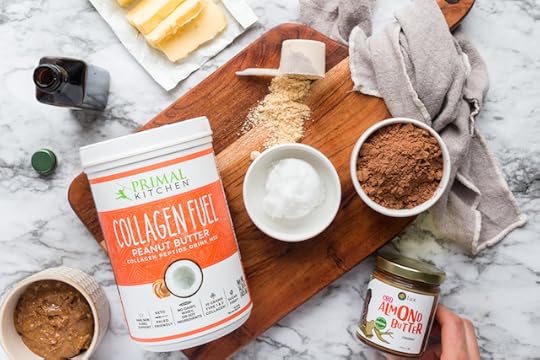
1/4 cup butter or ghee
1/4 cup coconut oil
6 Tbsp. almond butter (we used Lux CBD Almond Butter)
4 scoops Primal Kitchen Peanut Butter Collagen Fuel
1/2 cup cacao powder
1 tsp. vanilla extract
1/2 tsp. finely ground coffee
pinch of salt
Super dark or sugar-free chocolate for topping (optional)
Instructions:
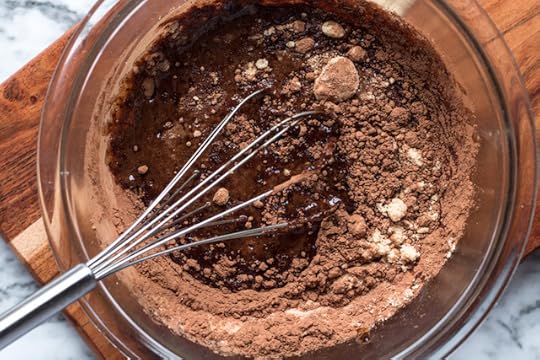
Melt the butter and coconut oil in a small saucepan.

Once melted, whisk in the almond butter. Transfer the mixture to a bowl and whisk in the collagen, cacao powder, vanilla extract, coffee and salt.

Pour the mixture into silicone molds of your choice.
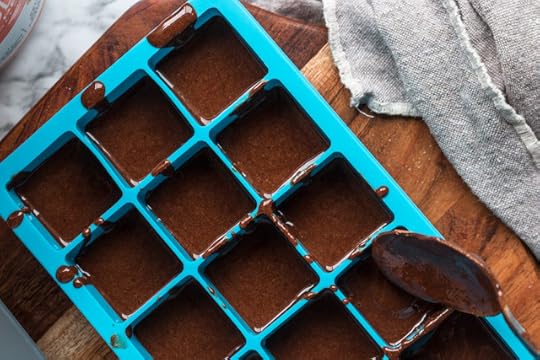
We used 1 tablespoon of the chocolate mixture in each mold, which yielded about 14 squares. Refrigerate the molds for 2-3 hours or until firm. Store in the fridge.
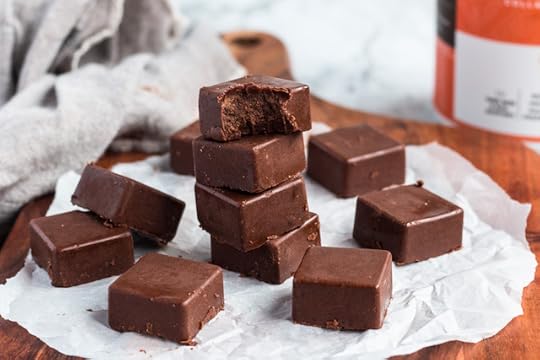
Optional: If you’d like, melt a little of your favorite dark or sugar-free chocolate. Dip the tops of the fat bombs in the chocolate and flip them over. Dust some collagen over the top as well if you’d like.
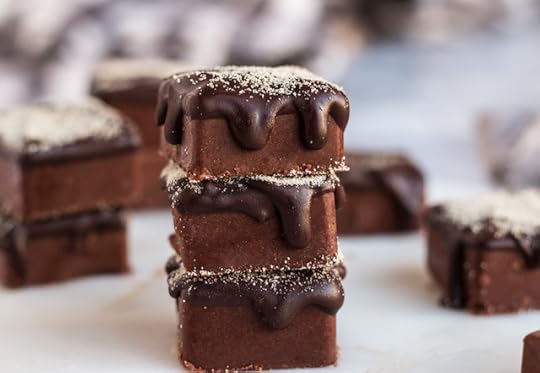
Nutrition Information (with regular almond butter—1 tablespoon worth of fat bomb mixture, or 1/14 of recipe):
Calories: 148
Total Carbs: 5 grams
Net Carbs: 3 grams
Fat: 13 grams
Protein: 5 grams
Nutrition Information (with Lux CBD Almond Butter — 1 tablespoon worth of fat bomb mixture, or 1/14 of recipe):
Calories: 140
Total Carbs: 7 grams
Net Carbs: 4 grams
Fat: 11 grams
Protein: 4 grams

The post Chocolate Peanut Butter Fat Bombs appeared first on Mark's Daily Apple.



December 27, 2019
Weekly Link Love — Edition 61

Research of the Week
The French are eating more soy (and soy isoflavones, estrogen mimetics) than ever before.
Not only does integrating livestock with organic crop rotation improve the health of the soil, it makes food safer.
A systematic review of the health effects of intermittent fasting.
Religiosity predicts cat ownership.
New Primal Blueprint Podcasts

Episode 395: Dr. Stephen Hussey MS, DC: Host Elle Russ chats with the good doctor, a functional medicine practitioner and chiropractor.

Primal Health Coach Radio, Episode 40: Laura and Erin chat with Sterling Griffin.
Each week, select Mark’s Daily Apple blog posts are prepared as Primal Blueprint Podcasts. Need to catch up on reading, but don’t have the time? Prefer to listen to articles while on the go? Check out the new blog post podcasts below, and subscribe to the Primal Blueprint Podcast here so you never miss an episode.
Media, Schmedia
The White House is considering making all scientific journals open-access.
A second HIV patient has apparently been cured.
Interesting Blog Posts
The phytoestrogen content of the Impossible Burger dwarfs that of normal beef, claims blog post.
Plasmalogen deficiency, and what you might be able to do about it.
Social Notes
Everything Else
After a fire, thousands of Atlantic salmon escape a British Columbia fish farm.
An interesting new study.
A high intake of sweets and restaurant food characterize the typical “high-carbon footprint” family, not high intake of meat.
Things I’m Up to and Interested In
Research I found interesting: Early human environments were totally unlike anything we see now.
Older news that remains sad: First ever cases of obesity in nomadic arctic peoples arise as venison and fish intake drop by half and noodle intake explodes.
I’m not surprised: How many vegans and vegetarians are actually eating animals?
Article I never expected to read: Did Michelangelo’s David have heart failure?
Article I’m sad to be reading: Are vegan diets detrimental to children’s growth and development?
Question I’m Asking
Should vegan diets for infants be illegal?
Recipe Corner
Paleo chocolate pudding.
Nishime—Japanese vegetable stew.
Time Capsule
One year ago (Dec 21– Dec 27)
12 Health Podcasts I’m Enjoying Lately – What are you listening to?
Does Carb Cycling Work? It Depends– How to make it work.
Comment of the Week
“Thanks for all you do, Mark and keep on Grok’in in the New Year! As for me, I’m off to Wal-Marsh for some fresh ‘gator armor.”
– Send me a set, would ya, Neanderchow? An elephant tusk ruined mine.

The post Weekly Link Love — Edition 61 appeared first on Mark's Daily Apple.



December 26, 2019
10 Tips For Rebuilding Fitness and Strength After Long-Term Injury, Illness or Atrophy
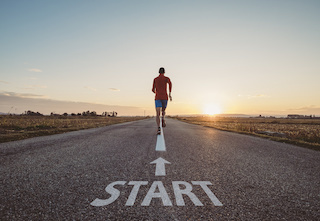 Maybe it’s an injury that took months to overcome. Maybe it’s an illness that left you bedridden (or demotivated). Maybe it’s simple disuse and neglect that dragged on and on—or lasted your entire life until today. Or maybe you read my recent post about claiming health in later life and want to get back on the road to vitality. For whatever reason, almost everyone will be forced to recover and rebuild their fitness and strength after an extended period of inactivity. But there’s a wrong way and a right way to do it.
Maybe it’s an injury that took months to overcome. Maybe it’s an illness that left you bedridden (or demotivated). Maybe it’s simple disuse and neglect that dragged on and on—or lasted your entire life until today. Or maybe you read my recent post about claiming health in later life and want to get back on the road to vitality. For whatever reason, almost everyone will be forced to recover and rebuild their fitness and strength after an extended period of inactivity. But there’s a wrong way and a right way to do it.
Here are some tips for doing it the right way:
1. Do Anything You Can
Isometric contractions in the hospital bed (only if allowed by your doc, mind you). Single leg squats when standing up from the couch with your good leg. Bicep curls with the one arm that isn’t incapacitated. Whatever movement you can muster, get moving.
While it’s definitely “better” to train your entire body, training just a single body part or limb is better than doing nothing. It sends a signal to your body that you haven’t thrown in the towel, that you still need your metabolically-expensive muscle mass.
2. Motion Is Lotion—but Only If It’s High Quality Motion
The quicker you can get back to normal movement, the better. Normal movement, not normal speed. Quality over everything. For instance, say you sprain your ankle. The best thing you can do to recover is to start walking on it with good technique. Once you can walk with good form, however slow you go, get walking. Walk without a limp, even if it’s 1 MPH. Walk without a limp, even if you have to use crutches or a cane to bear some of the load. Don’t roll onto the outside of your bad foot. Don’t splay that foot out like a duck to avoid the pain.
The point is moving—and moving well.
3. Eat Tons Of Protein
Inactivity increases the protein requirement. When you’re on bed rest (mandatory or self-imposed), your protein metabolism shifts toward that of an older person’s—lower efficiency, higher substrate requirements to attain the same result. You need more protein just to stay on top of daily maintenance. Plus, since you’re actively healing and recovering and laying down or repairing tissue, you need extra protein to handle the extra processes.
Eat a good 1 gram protein per pound of lean body mass as you prepare for your return to activity. Consider including whey isolate, as it’s an easy additive source of protein that’s been shown to improve recovery after bed rest and surgery.
4. Learn To Distinguish Between Pain and Soreness
When recovering from an injury or just getting back into exercise, you want to avoid pain. Sharp pains in the joints, strains in the tendons that you feel for days after, a pulled muscle—these are not okay.
But you will and should feel discomfort. Muscle soreness after a session is fine. It’s normal. Burning in the muscle during a session is fine. It’s normal. Pain is not. Avoid pain.
5. Go For Walks
Regular walking is a powerful signal of “abundance” to your body. It tells your body that you’re still in the game, that you’re engaged with the world and have places to be. Walking is also the simplest, most fundamental way to get the blood flowing, get your joints lubricated, and apply a low-level stimulus to your musculoskeletal system. Pretty much everyone can walk.
If you have access to hills, even better. Walk up and down hills as often as possible. A brisk uphill walk is a legitimate way to build strength and endurance.
Work your way up to 5 times a week of 30-45 minutes. Throw on a weighted vest or throw some books in your backpack to add resistance.
6. Do Bear Crawls
Slow bear crawls are a great way to loosen up your joints and prepare your shoulders and hips for more complex, weighted movements. They’re actually a good exercise in their own right, especially if you haven’t done them since you were a baby.
Do these several times a week, preferably in the morning or before workouts, for a few minutes each day. Crawl forward, backward, sideways in a controlled fashion, making sure you feel the movements.
7. Do Balance Work
One basic way to improve balance (or just get more comfortable in unstable positions) is to stand on one foot and slowly sweep the opposite foot across in front of and behind you. Switch feet and do this every day for a couple minutes, or whenever you have down time—standing in line, for example.
You can also buy a 2×4 from the hardware store, place it on the ground, and practice walking forward and backward along it. You get the benefit of balancing on a narrow surface without the risk of falling to your doom.
8. Start With Bodyweight Exercises
Basic movements: knee flexion (squat, lunge, split squat), hip hinge (deadlift, kettlebell swing, trap bar DL), push (pushup, overhead press, dip), pull (pullup, chinup, row variations). You can do just about all of them with bodyweight, with the only one that’s really hard to do without external weights being the hip hinge.
Grab the Primal Blueprint Fitness ebook. It’s free and provides a step-by-step progression for all the movements, from total beginner doing pushups on the wall and assisted pull-ups to experienced lifter doing feet elevated pushups and weighted pull-ups.
9. Consider Finishing With Bodyweight Exercises.
Bodyweight exercises are totally sufficient for most people. It’s all about the amount of work you’re willing to do and the amount of effort you’re willing to give. In fact, I made the case in this post that you could build incredible strength and general fitness simply using bodyweight exercises plus some weighted resistance for the lower body (perhaps, say, my new favorite exercise: the trap bar deadlift and its many variations).
10. Take Fish Oil or Eat Fatty Fish.
The benefits of seafood on recovery and bounce-back-ability are multifold:
First, seafood is a great source of bioavailable high-quality protein—protein you need to recover from whatever sidelined you.
Second, the long chain omega-3s have a potent anti-inflammatory effect that can improve your recovery and speed up your return to normal activity. They reduce pain and inflammation without curtailing the healing process. One study even found that high dose omega-3 intake increased physical activity, maintained physical function, and reduced the incidence of joint replacement in older adults.
Third, the long chain omega-3s also increase muscle protein synthesis, particularly in older adults (presumably with higher baseline inflammation levels). In other words, they make physical activity more anabolic. They improve your ability to build muscle, muscle that you’ve probably lost being injured and inactive.
That’s it, everyone. These are the tips and methods I’ve used to get myself back on my feet after a long layaway, and to help others do the same. If you have anything to add or questions to ask, do so down below. I’d love to hear what worked (and what didn’t) for you. Thanks for reading.

References:
Arentson-lantz EJ, Galvan E, Ellison J, Wacher A, Paddon-jones D. Improving Dietary Protein Quality Reduces the Negative Effects of Physical Inactivity on Body Composition and Muscle Function. J Gerontol A Biol Sci Med Sci. 2019;74(10):1605-1611.
Alfaddagh A, Elajami TK, Saleh M, Elajami M, Bistrian BR, Welty FK. The effect of eicosapentaenoic and docosahexaenoic acids on physical function, exercise, and joint replacement in patients with coronary artery disease: A secondary analysis of a randomized clinical trial. J Clin Lipidol. 2018;12(4):937-947.e2.
Smith GI, Atherton P, Reeds DN, et al. Dietary omega-3 fatty acid supplementation increases the rate of muscle protein synthesis in older adults: a randomized controlled trial. Am J Clin Nutr. 2011;93(2):402-12.
The post 10 Tips For Rebuilding Fitness and Strength After Long-Term Injury, Illness or Atrophy appeared first on Mark's Daily Apple.



December 25, 2019
Happy Holidays
 Good morning, everyone. The staff and I are off today, taking some time with our families, but I wanted to wish the best to you and yours today. Maybe you’re in the thick of preparing the big meal for your guests or in the bustle of travel to enjoy the day with loved ones. Or maybe you’re taking a quiet day to observe the holidays on your own at home or in the great outdoors.
Good morning, everyone. The staff and I are off today, taking some time with our families, but I wanted to wish the best to you and yours today. Maybe you’re in the thick of preparing the big meal for your guests or in the bustle of travel to enjoy the day with loved ones. Or maybe you’re taking a quiet day to observe the holidays on your own at home or in the great outdoors.
Whatever your circumstances and celebration, I hope the day offers you the chance to enjoy the experiences and connections that fill you, to honor the good in your life both past and present. As for me, I’m grateful today for my health, for my family and friends, for meaningful work, and for the gracious and inspiring community here. With best wishes to each and every one of you, Happy Holidays.

The post Happy Holidays appeared first on Mark's Daily Apple.



December 24, 2019
2019 In Review: My Favorite Events, Experiments and Trends
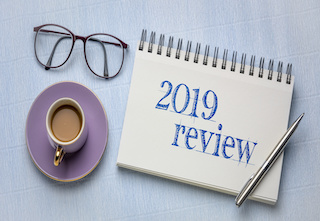 2019 was a big year here.
2019 was a big year here.
I’ll start with the obvious. I sold Primal Kitchen® to Kraft Heinz back at the start. And though some of you expressed doubt and skepticism (totally understandable), I’m happy to report that things are going great. The brand and its products are still as high quality as ever while appearing in more stores than ever before. In fact, they’re getting even better. It’s been great to offer more varieties and flavors of the products people enjoy, and with the increased power of Kraft Heinz we’re able to get the best manufacturing facilities (for instance, we’ve secured use of a facility that does not process wheat—a real rarity in the industry).
What else?
As always, I tried a bunch of stuff. Did some experimentation…
My Top 2019 Experiments
Kefir Megadoses
There was a paper from a few years ago talking about the connection between fermented foods and anxiety. Their basic conclusion was that fermented foods like sauerkraut and yogurt and kefir can actually reduce anxiety in the long term. That always stuck with me. I definitely don’t have anxiety, social or otherwise, but like I said I do care about the outcome. That can manifest as something like anxiety (without the neurosis). It’s “justified anxiety.”
So, I tried drinking a quart of kefir in a single day on those days when I have a lot going on, when I’m doing some planning or just feel a bit out of sorts, like I’m on the cusp of the future and have yet to fully commit. It worked. It smoothed things out. I’m still doing it semi-regularly as needed.
Verdict: Keepin’ it.
Rest-Pause Super Sets
Instead of taking an hour or 1.5 hours to train at the gym, I played with a new way of lifting that’s much quicker and more condensed. I pick a weight and lift it as many times as I can. Rest for 30 seconds. Do it again. Rest for 30 seconds. Do it again.
Sometimes I’ll do a final drop set. Drop the weight by 15% and do another set of max reps.
That’s under 5 minutes per exercise, I get a great workout, and because I don’t feel obligated (or able) to push really heavy weights, my risk of injury is lower.
Verdict: Keepin’ it.
Coffee experiments: I’ve always loved messing around with my coffee. It’s one of the most reliable and consistent things I put into my body. It makes a great vehicle for all sorts of tasty and nutrient-dense ingredients. So, what did I try?
Super Dark Stearic-Enhanced Ganache Coffee
Melt 1/2 bar of as dark a chocolate as you can handle in some cream, then add to coffee. Cocoa butter is rich in stearic acid, a saturated fat that causes mitochondria to fuse and become more efficient at fat-burning.
Verdict: Very filling. Provides steady energy. Might be worth trying if you want to cut calories. Delicious.
Hemp Coffee
Blend raw or toasted hemp hearts in hot or cold coffee along with Collagen Fuel, cinnamon, and sea salt. Provides an enormous dose of magnesium (which caffeine can deplete) and creaminess. Here’s the full recipe.
Verdict: Delicious, calming. I use it from time to time.
Now for the big picture….
My Take On 2019 Health Trends
Keto is solidifying. More people than ever have learned to access their own body fat for energy. Keto isn’t as “exciting” or “explosive” as it was, but even better is that it’s becoming normalized. No one bats an eye when you skip the bun at the burger joint or opt for more meat instead of fries. Normalization is where the real power lies. My upcoming book, Keto For Life, is all about harnessing keto as a normalizing force for the rest of your life.
The Carnivore Diet is also exploding in a very exciting way; research is scarce, but the cascade of powerful personal success stories is increasingly undeniable. Even if carnivore isn’t the answer, the fact that people aren’t dropping dead and actually seem to be thriving is a harsh rebuke to the standard line about diet and health. We can learn a lot from carnivory.
Meanwhile, the anti-meat conglomerate really showed their hand.
The EAT-Lancet commission unveiled its global target diet, consisting of 0.75 eggs per week, a rat paw-sized serving of red meat each day, and so, so many almonds.
The “meat is murder, not just for the animals and your health, but also for the planet” message was really hammered home harder than ever before. This might have been the most insidious side of the conglomerate—conflating a legitimate issue with the strawman vision of ruminants destroying the planet. Luckily, there are people and projects speaking back to the misinformation and offering a healthy and sustainable vision. I’m doing what I can to support them.
Game Changers—a slick, well-produced documentary buoyed by a ton of moneyed interests pushing the plant-based agenda—took the Netflix-watching world by storm. I’ve heard from hundreds of readers whose families, coworkers, friends are going (or are considering going) vegan after watching the film. Still not gonna watch it though.
Germany is mulling a meat tax.
Maybe it’s all a coincidence, and these are all isolated pushes from independent actors who simply want to make the world a better place. Or maybe not. Maybe it’s a coordinated effort to change how people eat across the world—less meat and more plant-based products. My money’s on the last one. Either way, there’s a big fight coming, folks. There’s a lot of money and power behind the plant-based push. That’s going to be the big story in the next decade.
Despite all that, the most important part of 2019 was very personal.
The Best Part Of 2019…
I became a grandpa.
And my genes felt it. They said “My gosh, Sisson, you’ve done it. You’ve made it. You’ve really made it.” Because after all, from a natural selection perspective, having kids yourself isn’t enough. Passing on your genes to the next generation isn’t sufficient. No, your genes want to see themselves carried over to the next-next generation, too. And yeah, this hasn’t been quantified in the lab or anything, but it’s real. That’s the promised land for your heritage. You mean to tell me your genes don’t sense the shift? Mine definitely did.
Becoming a grandpa also made me wonder about the “source” of all this. Because that kid is a real miracle.
What does your 2019 roundup look like? I’d like to hear about the food, health, and fitness stories and experiments that resonated with you the most, but I’d love to hear about the personal journey you took. What were your defeats? Your victories? What did you love? What did you learn about the world or about yourself? What made you stop and reconsider what this thing we call life and existence is all about?
Tell me everything. And enjoy these last few days of 2019.

The post 2019 In Review: My Favorite Events, Experiments and Trends appeared first on Mark's Daily Apple.



December 23, 2019
I’m 55 and Feel Like I’m 20
It’s Monday, everyone! And that means another Primal Blueprint Real Life Story from a Mark’s Daily Apple reader. If you have your own success story and would like to share it with me and the Mark’s Daily Apple community please contact me here. I’ll continue to publish these each Monday as long as they keep coming in. Thank you for reading!
 My progress will forever be in the works. But it does have a beginning.
My progress will forever be in the works. But it does have a beginning.
I wasn’t born fat. I never even thought about weight or body fat until I realized that I had become too chubby. Around the age of 14 or so. I guess the hormonal changes and probably the decreased activity did it. Not really sure. Because I had always eaten incorrectly for my body. Too much sugar, wheat, processed foods. My belly has been bloated for as long as I can remember. I remember eating Grape Nuts as a kid and feeling bloated minutes later. I never put two and two together, until much later. Even though I was nowhere near fat then, food was still having an extreme effect on my health.
After having my two children, things got worse. I focused on them and forgot about who I was. Being a mom, wife and working a full-time job literally left nothing in the tank for me. I was still bloated, stressed out and definitely sugar addicted.

And then the weight crept on. By the time I was 45, I was at least 70 pounds overweight. And, I felt horrible. And because my children were almost grown, I was also able to see it and feel it more. I was depressed. And I ate more chocolate.
I remember clearly one fall day, raking (or attempting to rake) the lawn. My whole body felt like it was on fire. My back had sharp pains and I was too out of shape to complete the task. That was my final straw. I started to research a solution. Even though I knew a lot about food and what I shouldn’t be eating, I had so much more to learn. The diet choices were endless, but I settled on a well-known one, The South Beach Diet. And my journey began. My body was happy with the lower carbs (I still didn’t understand the sugar/gluten issues), and I immediately began to feel better. I ordered a kettlebell exercise program and began my journey into fitness. By the time my son was getting married in 2012, I had lost 30 pounds, and I was feeling pretty good about the way that I looked. But I still had the nagging stomach issues and bloat, and I was still clearly addicted to sugar.
In June 2013, my youngest son was home from college, and I got it into my head that he and I would find something we could do together for the summer. I happened to open the paper and see an article for the grand opening of a Crossfit gym in our hometown. I mentioned it to him and he said, yes, he had heard of Crossfit and we should try it. Full disclosure, I had never heard of Crossfit and I wonder now, if I had, if I would ever have wandered into that gym.
That weekend, he and I checked out the gym and committed to three days a week, starting the following Monday. Ironically, that week is also the week my best friend died of breast cancer. There were so many things in play at that time, I find it hard to sort out in my head, but I credit Crossfit for getting me through it. One, because I was so sore and tired, it was hard to think of anything but my body and two, I felt instantly like I was doing what was right for my body. My emotional pain was lessened by my physical pain—and little did I know, I was training my mind to beat anything that came before me.
A lot of Crossfit gyms prescribe to the Paleo method of eating, and this gym was no different. Eight months after I began my journey, they posted a Paleo challenge, using the Zone method of eating. After I completed that challenge and within the next few months, I had dropped another 40 pounds, literally without trying. My body had finally found the way it needed to be fueled, to maintain its optimum weight.

 Since then, I have continued to Crossfit (just started my seventh year) and I eat Paleo for the most part. I have dabbled with Keto and found that I always go back to not wanting the strictness of counting carbs. I just eat veggies, with a bit of fruit. I eat no grain still (found that was my poison) and try to make/eat any treat I have without sugar (I have found sugar substitutes that work).
Since then, I have continued to Crossfit (just started my seventh year) and I eat Paleo for the most part. I have dabbled with Keto and found that I always go back to not wanting the strictness of counting carbs. I just eat veggies, with a bit of fruit. I eat no grain still (found that was my poison) and try to make/eat any treat I have without sugar (I have found sugar substitutes that work).
I prescribe to the Big Ass Salad method and faithfully eat one every day at lunch. We raise chickens, so I eat plenty of fresh eggs and meat too. I believe in organic and whole food. Simple is better for me. No processed foods.
My weight may fluctuate 5 pounds or so now, but I remain lean and fit. I have gained quite a bit of muscle over the years, and I wouldn’t consider myself thin.
But here’s the thing. I am 55 and I feel like I am 20. I have no aches and pains (other than sore muscles). My resting heart rate is 50 and my blood pressure is awesome. I take NO prescription drugs. Could I drop dead tomorrow? Yes, and I truly hope that is the way that I will go. But I won’t finish out my life in the same shape I was in 10 years ago. It has been a long journey and not one that you can describe to younger people, but to the older ones who know, isn’t life great when you feel awesome?
I hope this inspires someone who may just be at that tipping point. When you find your groove, it will transform you and your relationships and how you see everything else in life.
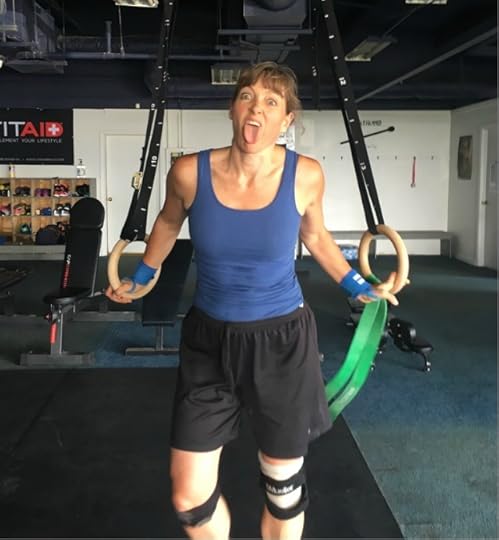

The post I’m 55 and Feel Like I’m 20 appeared first on Mark's Daily Apple.



Mark Sisson's Blog
- Mark Sisson's profile
- 199 followers



